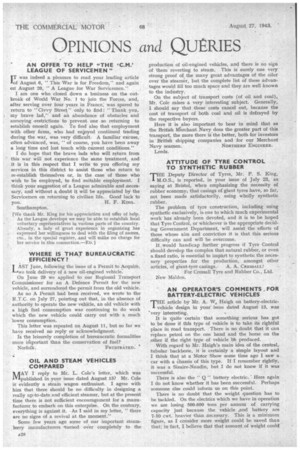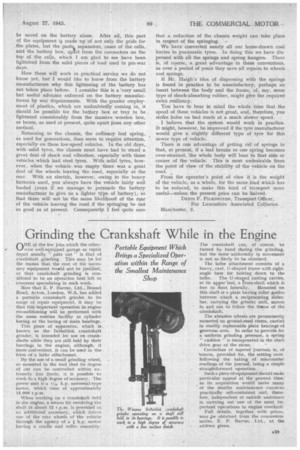OPINIONS and QUERIES AN OFFER TO HELP , , , THE 4 C.M.' LEAGUE
Page 30

Page 31

If you've noticed an error in this article please click here to report it so we can fix it.
OF SERVICEMEN" I T was indeed a pleasure to read your leading article of August 6, "This War is for Freedom," and again on August 20, "A League for War Servicemen."
I am one who closed down a business on the outbreak of World War No. 1 to join the Forces, and, after serving over four years in France; was spared to return to "Civvy Street" only to find : "Thank you, ray brave lad," and an abundance of obstacles and annoying -restrictions to prevent one so returning to establish oneself again. To find also that employment with other firms, who had enjoyed continued trading during the war, was very difficult. A familiar excuse, often advanced, was, "of course, you have been away a long time and lost touch withcurrent conditions."
I do hope that the brave lads who will return from this war will not experience the same treatment, and it is in this respect that I write to you offering my services in this district to assist those who return to re-establish themselves or, in the case of those who wish to be employed, to find suitable employment. I think your suggestion of a League admirable and .necessary, and without a doubt it will be appreciated by the Servicemen on returning to civilian life. Good luck to you. H. F. KING. Southampton.
[We thank Mr. King for his appreciation and offer of help. As the League develops we may be able to establish local voluntary representatives in various parts of the country. Already, a lady of great experience in organizing has expressed her willingness.to deal with the filing of names, etc., in the special register, and will make no charge for her service in this connection.—ED.] WHERE IS THAT BUREAUCRATIC EFFICIENCY?
LAST June, following the issue of a Permit to Acquire, we took delivery of a new oil-engined vehicle. On June 29 we applied to our RegionalTransport Commissioner for an A Defence Permit for the new vehicle, and surrendered the permit from the old vehicle.
As no A Permit had been received, we wrote to the R.T.C. on July 27, pointing out that, in the absence of authority to operate the new vehicle, an old vehicle with a high fuel consumption was continuing to do work which the new vehicle could carry out with a much 'lower consumption.
This letter was repeated on August 11, but so far we have received no reply or acknowledgment. • Is the leisurely completion of bureaucratic formalities more iriaportant than the conservation of fuel?
Norfolk. FRUSTRATED.
OIL AND STEAM VEHICLES COMPARED.
RANI' I reply to Mr. L. Cole's letter, which was LVIpublished in your issue dated August 13? Mr. Cole ie evidently a steam wagon enthusiast. I agree with him that there should be no difficulty in designing a really up-to-date and efficient steamer, but at the present time there is not sufficient encouragement for a manufacturer to embark on this enterprise. On. the contrary, everything is against it. As I said in my letter, " there are no signs of a revival at the moment."
Some few years ago some of our important steamlorry manufacturers 'turned over completely to the production of oil-engined vehicles, and there is no sign of them reverting to steam. This is surely one very strong proof of the many great advantages of the oiler over the stea.mer, but the complete list of these advantages would fill too much space and they are well known to the industry.
On the subject of transport costs (of oil and coal), Mr. Cole raises a very interesting subject. Generally, • I should say that these costs cancel out, because the cost of transport of both coal and oil is defrayed by the respective buyers.
Here it is also important to bear in mind that as the British Merchant Navy does the greater part of this transport; the more there is the better, both for investors in British shipping companies and for our Merchant Navy seamen. NORTHERN ENGINEER. Leeds.
ATTITUDE OF TYRE CONTROL TO SYNTHETIC RUBBER
THE Deputy Director of Tyree, Mr. P. S. King, 141.0.S., is reported, in your issue. of July 23, as saying at Bristol, when emphasizing the necessity of rubber economy; that casings of giant tyres have, so far, not been made satisfactorily, using wholly synthetic rubber.
The problem of tyre construction, including using synthetic exclusively, is one to which much experimental work has already been devoted, and it is to be hoped that Tyre Control, or whichever is the appropriate deciding Government Department, will assist the efforts of those whose aim and conviction it is that this serious difficulty can and will be overcome.
It_would handicap further progress if Tyre Control should develop the complex that natural rubber, or even a fixed ratio, is essential to impart to synthetic the necessary properties for the production, amongst other articles, of giant-tyre casings., A. A. CRESSALL,
For Cressall Tyre and Rubber Co., Ltd. New Malden, AN OPERATOR'S COMMENTS . FOR BATTERY-ELECTRIC VEHICLES
THE article by Mr. A. W, Haigh on battery-electric1 vehicle design in your issue dated August 18, was
very interesting. e It is quite certain that something serious has got to be done if this type of vehicle is to take its rightful place in road transport. There is no doubt that it can replace petrol on the one hand and the horse on the other if the right type of vehicle lie produced.
With regard to Mr. Haigh's main idea of the central,. tubular backbone, it is certainly a simple layout and I think that at a Motor Show some time ago I saw a car with a Chassis of this type. If I remember rightly, it was a Sizaire-Naudin, but I do not know if it was successful.
There is also the " Q " Battery electric. Here again I do not know whether it has been successful. Perhaps someone else could inform us on this point.
There is no doubt that the weight question has to be tackled. On the electrics which we have in operation we are losing 500-600 tons per annum of carrying capacity just because the vehicle ,and battery are 7-10 cwt. heavier -than neceasary. This is a minimum figure, as I consider more weight could be saved than that; in fact, I believe that that amount of weight could
be saved on the battery alone. After all, this. part of the equipment i§ made up of not only the grids for the plates, but the paste, separators, cases of the cells, and the battery box, ap3rt from the connectors on the top of the cells, which I am glad to see have been lightened from the solid pieces of lead used in pre-war days.
How these will work in practical service we do not know yet, but I would like to know from the battery manufacturers why this lightening of the battery has not taken place before. I consider this is a 'very small but useful advance enforced on the battery manufacturers by war requirements. With the greater employment of plastics, which are undoubtedly coming in, it should be possible for the b4ery box or tray to be lightened considerably from the massive wooden box, or boxes, as used at present, quite apart from any other method.
Returning to the chassis, the ordinary leaf spring, as used for generations, does seem to require attention, especially on these low-speed vehicles. In the old days, with solid tyres, the chassis must have had to stand a great deal of shock and vibration; especially with those vehicles which had steel tyres. With solid tyres, however, when the vehicle was empty there was a great deal of the wheels leaving the road, especially at the rear. With an electric, however, owing to the heavy batteries used, you always have the vehicle fairly well loaded (even if we manage• to persuade the battery manufacturer to give Us a lighter type of battery),. so that there will not be the same likelihood of the rear of the vehicle leaving the road if the springing be not as good as at present. Consequently I feel quite sure
that a reduction of the chassis weight can take place in respect of the springing.
We have converted nearly all our horse-drawn coal lorries to pneumatic tyres. In doing this we have dispensed with all the springs and spring hangers. There is, of course, •a great advantage in these conversions. as over a period of years they save all repairs to wheels and springs,
If Mr. Haigh's idea of dispensing with the springs is found in practice to be unsatisfactory, perhaps an insert between the body and the frame, of, say, some type of shock-absorbing rubber, might give the required extra resiliency.
You have tb bear in mind the whole time that the speed of these vehicles is not great, and, therefore, you strike holes on bad roads at a much slower speed.
I believe that the system would work in practice. It might, however, be improved if the tyre manufacturer would give 'a slightly different type of tyre for this newer type of. vehicle.
There is one advantage of getting rid of springs in that, at present, if a leaf breaks or one spring becomes over-strained, the whole body will lean to that side or corner of the vehicle. This is most undesirable from the point of view of the stability of the vehicle on the road.
From the operator's point of view it is the weight of the vehicle, as a whole, for the same load which has to be reduced, to make this kind of transpOrt more useful—unless the present price can be halved.
DENIS F. PILKINGTON, Transport Officer, For Lancashire Associated Collieries. Manchester, 2.




















































